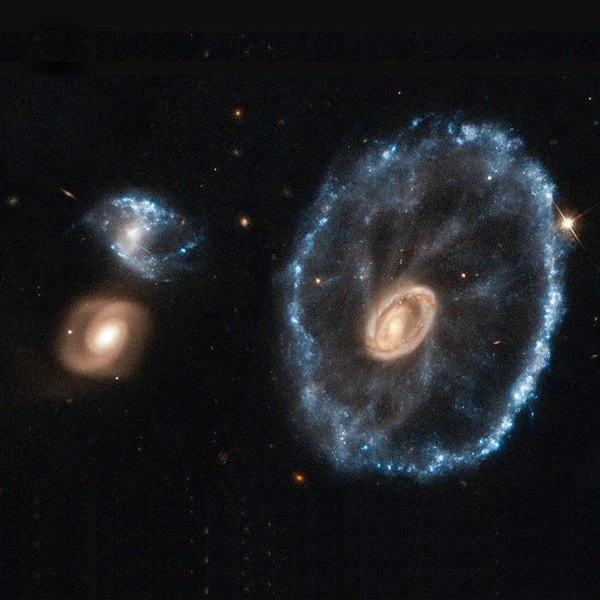
The Cartwheel Galaxy (ESO 350-40) is a ring galaxy located about 500 million light-years away in the constellation Sculptor. Its spectacular shape, resembling a wagon wheel, is the result of a head-on collision with a smaller galaxy that occurred several hundred million years ago.
The impact triggered a density wave that spread outward, compressing interstellar gases and causing massive star formation, colored blue. This wave, similar to a shock wave, is responsible for the bright outer ring, rich in young blue stars and very active HII regions. HII regions get their name from the large amount of ionized hydrogen H+, which is a simple proton.
The Cartwheel Galaxy is the result of a nearly central head-on collision with a smaller intruder galaxy. This collision compressed the gases and dust of the disk, triggering the formation of a ring of stars, but also expelled interstellar gas and dust to the outer regions, under the effect of gravitational pressure and the inertia of the outer layers. This small blue cloud, shaped like an eye, is visible outside the wheel.
The image captured by the Hubble Space Telescope in the 1990s revealed for the first time the spectacular shape of the Cartwheel Galaxy. In the visible domain, Hubble shows a blue outer ring rich in young massive stars, a more diffuse inner structure, and filaments of matter expelled by the collision. The core appears as a bright spot with little detail, partly masked by interstellar dust. The arc-shaped arms suggest a propagation of density waves, but the limited resolution and sensitivity to infrared restrict the reading of internal processes. Despite this, this image marked a turning point in the understanding of ring galaxies, providing a striking visual testimony of a violent interaction.

The image acquired by the James Webb Telescope in 2022 has redefined the observation of the Cartwheel Galaxy. Thanks to its NIRCam (near-infrared camera) and MIRI (mid-infrared camera) instruments, JWST pierces through the dust curtains and reveals an extraordinarily complex internal structure. Fine filaments, pockets of star formation in the inner ring, and previously invisible details in the galactic core can be seen. The thermal radiation from hot dust and young stars becomes apparent, showing the spatial propagation of the shock wave at the very heart of the galaxy. This image reveals a snapshot of a dynamic system in full reorganization, inaccessible to the optical eye.
Since its launch in 1990, the Hubble Space Telescope (HST) has revolutionized our understanding of the cosmos with its observations in the visible and near-ultraviolet domains. Its images of unparalleled precision clearly reveal hot stars, distant galaxies, and regions little obscured by interstellar dust.
The James Webb Telescope (JWST), deployed in 2021, complements this vision by opening a window on the infrared (0.6 to 28 µm). This capability allows it to penetrate dust clouds, study cold objects invisible to Hubble, and map buried stellar nurseries. Where Hubble excels in the morphological analysis of cosmic structures, JWST explores their hidden dynamics, such as supermassive black holes or the first galaxies born after the Big Bang.
Together, these two giants form a complementary duo: Hubble depicts the visible scene of the Universe, while Webb reveals its behind-the-scenes, offering astronomers an integrated vision of galactic evolution.